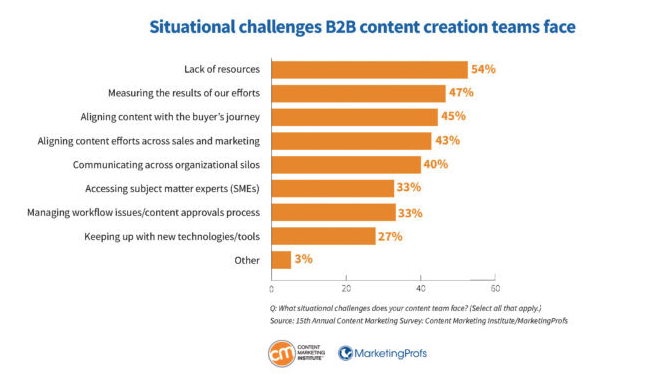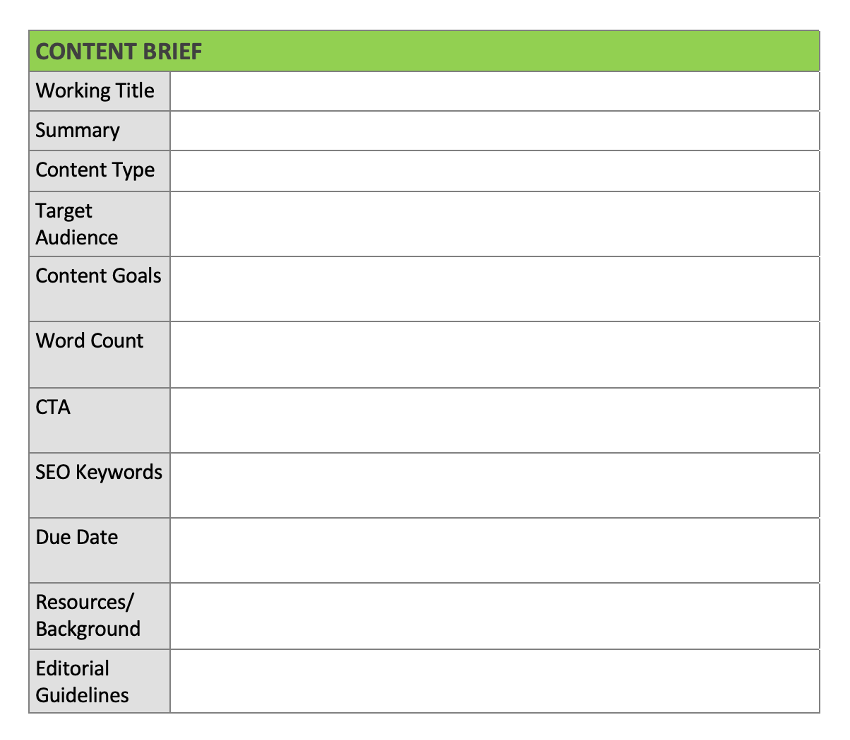Most marketers agree that it’s getting more challenging to generate content that supports and enhances their business. In fact, 39% of B2B marketers say that producing enough content is still a big challenge. And it’s no wonder, as demand for online content continues to go up, even as resources are often limited or lacking:

So how can you find creative, cost-effective ways to fill your content marketing pipeline? With effective content collaboration: tapping other teams and colleagues outside marketing to help with content creation. The problem is, too few marketers are successful at tapping into these in-house resources. According to CMI’s Outlook for 2025 Benchmark report, 33 percent of marketers find it a challenge accessing subject matter experts outside of marketing to contribute content (see above graph).
The Art and Science of Content Collaboration
If you’re not sure how to reach out and engage your non-marketing colleagues, we’ve got you covered. Check out our eight content collaboration tips to get busy co-workers to contribute content for maximum benefit and reach.
1. Get Buy-in and Support from Leadership
When the leadership team is in your corner, it will be much easier to get colleagues outside of marketing to pitch in. Show your executive team the value content brings to the business and its impact on the bottom line; in turn, they can stress the importance of providing quality content for your customers from across the entire organization.
If possible, get top-down buy-in to turn cross-functional content development into a company priority. And set up policies outlining minimum content contributions—e.g., one article or blog post per month or quarter—from various departments.
In addition, work with leadership to identify thought leaders in sales, customer success, engineering, and other teams to represent the company. Then determine which types of content—e.g., content comprising high-level strategy or the corporate narrative—will require executive approvals prior to publishing.
2. Give Employee Incentives and Acknowledgment
Sometimes all it takes is a gift card or other perk to motivate your co-workers to create content. Consider going one step further and providing incentives based on performance—number of views, number of shares, number of comments, number of leads, etc. This will help spur your colleagues to create higher-quality, customer-centric content.
If your budget doesn’t allow for monetary rewards, then focus on giving credit where credit is due: Acknowledge contributors in your all-hands meetings or via company-wide emails when their content has helped drive engagement or converted leads. Giving them kudos will help encourage further content marketing collaboration.
As well, introducing a little friendly competition, especially within your sales team, can prove to be a big motivator. Consider setting up a leaderboard to track performance and announce key wins at sales kickoff or company meetings.
3. Appeal to Your Colleagues’ Interest in Building Their Brand
Authoring high-quality content can elevate your colleagues’ expert status, helping them build their own personal brand. In this way, they can gain greater recognition and credibility in the industry, thereby capturing more business with new and existing customers.
Make this a selling point when engaging with your non-marketing colleagues. Whether it’s a tip of the day, employee spotlight, or a timely blog post they’ve written that’s then shared across LinkedIn, Facebook, and X, these types of content can build authority not only for the individual but the company as well.

4. Involve Contributors in the Brainstorming Process
Involve teams outside marketing—particularly your sales folks—early on. Making them feel like they’re part of the brainstorming process will give them a strong sense of ownership. And it can help uncover topics and priorities you may not have considered that can help re-energize your content strategy.
Work together to come up with topics that your non-marketing colleagues believe in and care about—and that align with business and user needs. These content collaboration efforts will help make the assignment more meaningful and therefore much easier to write.
5. Provide Structured Content Templates or Briefs
The more guidance you can provide, the easier it will be for your colleagues to fill the content hopper. Templates or briefs that outline the content assignment will help your colleagues feel more comfortable, especially when they’re first starting out as content creators.
Providing a detailed content brief will also help your contributor stay on topic and on brand. Include elements such as a working title, summary or description, content type, target audience, word count, links to examples and resources, editorial guidelines, call to action, SEO keywords, and due date.

6. Create and Share an Editorial Calendar
Put together a content calendar—which includes key milestones, deadlines, and performance metrics—and share it with all of your content creators. A calendar can help reinforce the importance of each contributors’ responsibilities not just to the marketing function, but to the company as a whole. Such a calendar helps keep contributors accountable, as they can see how vital their role is in producing content that engages and converts customers.
Just be sure to afford each contributor a reasonable amount of time to develop content and consider including interim checkpoints or reminders to gently nudge them toward completion.
7. Interview and Ghost Write for Subject Matter Experts
It’s likely that some subject matter experts (SMEs) at your organization—especially those on your leadership team—won’t have time to write content, whether it’s a blog post, article, or case study. But most will be able to spare 30 minutes to talk with you about a topic they’re passionate about. Set up interviews with these experts, then turn that material into a blog post with their byline. Or grab a quote or insight and use it in another story you’re writing, or post it onto your social platforms.
In some cases, you may be able to get executive buy-in to record the audio and video of these interviews, which can be repurposed for FAQs, demos, explainers and how-tos that you can share with your audience.
If your SMEs don’t have time to sit down for an interview, then see if they can share their thoughts in an email. Show them the performance results of your content collaboration, so that they’re more likely to help out in larger ways down the line.
8. Repurpose Existing Content
Various teams—sales, product, customer support, engineering, and design—have no doubt produced a ton of content shared both inside and outside your company. Whether it’s all-hands or townhall presentations, departmental news, customer service call scripts, product roadmaps, buyers’ journeys, quarterly plans, and playbooks, these are all items that may be fair game for content marketing.
Assuming the content you’re looking to repurpose isn’t confidential competitive information, you may be able to successfully funnel them into your company blog, marketing campaigns, social media posts, white papers, and more. Maintaining open lines of communication with your non-marketing colleagues will allow you to stay abreast of the latest and greatest content they’re churning out—and that you can reuse and distribute elsewhere.
Closing Thoughts on Content Collaboration
Applying even a few of these tips should help you increase your pipeline of customer-focused content with little to no cost to your marketing budget. Just remember: To win over your non-marketing colleagues, you must demonstrate the value that content brings to the business. Show them the ROI from their contributions to keep the content collaboration going.
Need Help Eliminating Collaboration Silos?
Tendo can align your people—as well as your processes and technologies—evolving your content operations to achieve outstanding results. Reach out to learn how we can help you scale content production efficiently and effectively.
First published January 22, 2022










